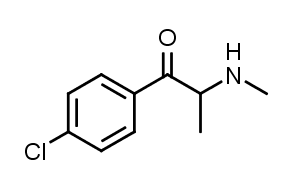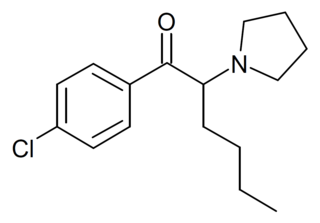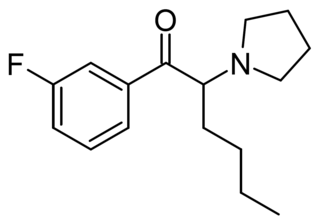
α-Pyrrolidinopropiophenone (α-PPP), is a stimulant drug. It is similar in structure to the appetite suppressant diethylpropion and has analogous effects in animals. Little is known about this compound, but it has been detected by laboratories in Germany as an ingredient in "ecstasy" tablets seized by law enforcement authorities. This drug has been found to produce stimulant effects in animals and produces highly stimulating effects in humans, based on the experiences of the individuals who have tried it. Most of the individuals who have tried it prefer α-PVP to it, but prefer this drug over α-PVT. It is said to lack euphoria compared to α-PVP.

3',4'-Methylenedioxy-α-pyrrolidinobutyrophenone (MDPBP) is a stimulant of the cathinone class developed in the 1960s, which has been reported as a novel designer drug. MDPBP is sometimes sold under the name "NRG-1" as a mixture with other cathinone derivatives, including flephedrone, pentylone, MαPPP and its higher homologue MDPV. As with other cathinones, MDPBP has been shown to have reinforcing effects in rats.

α-Pyrrolidinopentiophenone is a synthetic stimulant of the cathinone class developed in the 1960s that has been sold as a designer drug and often consumed for recreational reasons. α-PVP is chemically related to pyrovalerone and is the ketone analog of prolintane.

Substituted cathinones, which include some stimulants and entactogens, are derivatives of cathinone. They feature a phenethylamine core with an alkyl group attached to the alpha carbon, and a ketone group attached to the beta carbon, along with additional substitutions. Cathinone occurs naturally in the plant khat whose leaves are chewed as a recreational drug.

α-Pyrrolidinohexiophenone is a synthetic stimulant drug of the cathinone class developed in the 1960s which has been reported as a novel designer drug.

α-Pyrrolidinopentiothiophenone is a synthetic stimulant of the cathinone class that has been sold online as a designer drug. It is an analogue of α-PVP where the phenyl ring has been replaced by thiophene.

4-Methylbuphedrone, is a stimulant drug of the cathinone class that has been sold online as a designer drug.

4'-Methoxy-α-pyrrolidinopentiophenone is a stimulant drug of the cathinone class that has been sold online as a designer drug.

4-Chloromethcathinone is a stimulant drug of the cathinone class that has been sold online as a designer drug.

4-Chloro-alpha-pyrrolidinovalerophenone is an emerging recreational designer drug of the pyrrolidinophenone class, similar in structure to alpha-pyrrolidinopentiophenone (α-PVP). The pharmacology and toxicity of this compound is unknown, though it is presumed to be a stimulant drug.

N-Ethylhexedrone (also known as α-ethylaminocaprophenone, N-ethylnorhexedrone, hexen, and NEH) is a stimulant of the cathinone class that acts as a norepinephrine–dopamine reuptake inhibitor (NDRI) with IC50 values of 0.0978 and 0.0467 μM, respectively. N-Ethylhexedrone was first mentioned in a series of patents by Boehringer Ingelheim in the 1960s which led to the development of the better-known drug methylenedioxypyrovalerone (MDPV). Since the mid-2010s, N-ethylhexedrone has been sold online as a designer drug. In 2018, N-ethylhexedrone was the second most common drug of the cathinone class to be identified in Drug Enforcement Administration seizures.

α-PCyP is a stimulant drug of the cathinone class that has been sold online as a designer drug. In a series of alpha-substituted pyrrolidinyl cathinone derivatives developed in 2015, the alpha-cyclopentyl derivative was found to have around the same potency in vitro as an inhibitor of the dopamine transporter as the alpha-propyl derivative α-PVP, while the alpha-cyclohexyl derivative α-PCyP was around twice as strong.

α-Pyrrolidinoisohexanophenone is a stimulant drug of the cathinone class that has been sold online as a designer drug. It is a positional isomer of pyrovalerone, with the methyl group shifted from the 4-position of the aromatic ring to the 4-position of the acyl chain. In a classic 2006 study of pyrrolidinyl cathinone derivatives by Meltzer et al. at Organix, the alpha-isobutyl derivative of pyrovalerone, O-2494, was found to have the highest potency in vitro as an inhibitor of the dopamine transporter of the alpha substituted derivatives tested. A-PHiP probably acts as a selective dopamine reuptake inhibitor. Unlike other alphas, which also act clearly on norepinephrine and are not so selective, alpha-pihp shows a very high selectivity for dopamine and has a stronger effect on dopamine. It has very little or no effect on serotonin and norepinephrine. It practically only affects dopamine receptors and inhibits almost only dopamine. In July 2016 α-PHiP was first identified as a designer drug when it was reported to the EMCDDA by a forensic laboratory in Slovenia.Due to the fact that it is a very strong and very selective dopamine reuptake inhibitor, it is considered very compulsive and prone to causing psychosis and paranoia, just like other alphas.

TH-PVP is a substituted cathinone derivative which has been sold as a designer drug. It was first identified by a forensic laboratory in Hungary in 2015, but has subsequently been found in numerous other countries around the world including Spain, Belgium, Poland, Turkey and Brazil. Pharmacological studies in vitro showed it to inhibit reuptake and promote the release of monoamine neurotransmitters with some selectivity for serotonin, but it failed to produce stimulant effects in animals, and has a pharmacological profile more comparable to that of sedating empathogens such as MDAI and 5-Methyl-MDA.

O-2390 is a recreational designer drug from the substituted cathinone family, which acts as a potent inhibitor of dopamine and noradrenaline reuptake in vitro, with weaker but still significant inhibition of serotonin reuptake.

MFPVP (3-Methyl-4-fluoro-α-pyrrolidinovalerophenone) is a recreational designer drug from the substituted cathinone family, with stimulant effects. It was first identified in Sweden in April 2020 and was among the most widely encountered substituted cathinone derivatives in 2021, though it since appears to have declined in prevalence. It is illegal in Virginia.

2-Methyl-alpha-PVP (2-Me-PVP) is a substituted cathinone derivative with stimulant effects which has been sold as a designer drug. It was first identified in Sweden in 2021.

4-Chloro-alpha-Pyrrolidinohexiophenone (4-Cl-PHP) is a substituted cathinone derivative with stimulant effects, which has been sold as a designer drug. It was first officially identified by forensic laboratories in 2016, though anecdotal reports suggest it may have been available several years prior to this.

3-Fluoro-alpha-PHP (3F-PHP) is a substituted cathinone derivative with stimulant effects which has been sold as a designer drug. It was first identified in Sweden in 2020 and continues to be detected in seized drug samples, though it appears to have been less widely used than related compounds such as 3F-PVP and 3F-PiHP.



















